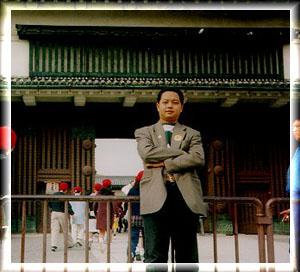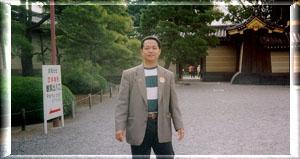
Kyoto Sightseeing Morning Tour
How nice... JICA has arranged a Kyoto sightseeing morning tour. If not mistaken, I think each person's fee was about Y5000. The tour company was known as Sunrise Tour. For the morning tour, normally the tour covers Nijo Castle, Golden Pavilion, Kyoto Imperial Palace and Kyoto Handicraft Center.

Nijo Castle
:
Nijo Castle used to be the Kyoto residence of the Tokugawa Shogun built in 1603. This castle is noted for the contrast of its solemn appearance and gorgeous interiors.

Golden Pavilion
:Golden Pavilion is the most authentic and exquisite Japanese style garden in the world, plus the celebrated Gold Pavilion.

History: Kinkaku-ji (Temple of Golden Pavilion) is the popular name for this temple which is properly called Rokuon-ji. In the 1220's it was the comfortable villa for Kintsune Saionji. Yoshimitsu, the 3rd Shogun of Ashikaga, abdicated the throne in 1394. After three years, he began to build Kitayamaden and he made a special effort to make Kinkaku a breath-taking site. He indulged in his peaceful life in this serene setting. After Yoshimitsu's death, Kinkaku was made into a Zen temple in accordance to his will. All the buildings of those days came to ruin except Kinkaku. The garden, however, remains as it was in the former days and can be enjoyed as it was hundreds of years ago.
Building: Kinkaku was formelly called Shariden. The elegant, harmonious building consists of three types of architecture. The 1st floor is Shinden-zukuri, the palace style. It is named Ho-sui-in. The 2nd floor is Buke-zukuri, the style of the samurai house and is called Cho-on-do. The 3rd floor is Karayo style or Zen temple style. It is called Kukkyo-cho. Both the 2nd and 3rd floors are covered with gold-leaf on Japanese lacquer. The roof, upon which the Chinese phoenix settles, is thatched with shingles. During the recent years, however, the structure has become damaged, and has required extensive repairs to be undertaken, such as the restoration of the artwork on the ceiling and the renovation of the gold-leaf. The present gold-leaf is five times thicker than the original. By October 1987, Kinkaku had been restored to its original splendor.
Point of Interest: The name of the pond is Kyoko-chi (Mirror Pond). The pond contains many large and small islands. Climbing a few steps, you stand at the edge of another small pond, An-min-taku. The small stone pagoda on the island is called Hakuja-no-tsuka (the mound in memory of the white snake). The classic tea house is called Sekka-tei. In Sekka-tei, there is a celebrated pillar made of a nandin. The house was restored in 1997. On the way to the exit of the temple, one will find the small Fudodo shrine where the stone Fudo-myoo (Acara) is enshrined as a guardian.

Kyoto Imperial Palace
:
Kyoto Imperial Palace, on the other hand, is the ancient Imperial Palace which clearly shows the Japanese taste of purity, simplicity and calmness.
Kyoto Handicraft Center:
Finally, in the Kyoto Handicraft Center, one will enjoy demonstration for Japanese traditional arts and crafts; as well as shopping.
Located on Marutamachi, north of Heian Shrine Kyoto, one can find a large variety of Japanese Goods such as kimono, woodblock prints, chinaware, pearls, jewelry, coral, pottery, bags, antiques, art goods, swords, cameras, stationeries, fans, screens & scrolls, dolls, graphic arts, damascene, electrical appliances, watches, toys, t-shirts, lacquerware, cloisonne and many more.